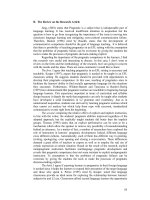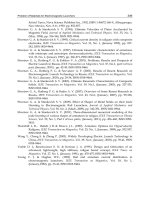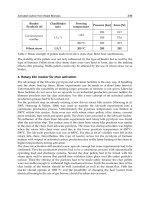Composites Manufacturing - Materials, Product, and Process Engineering Part 13 ppt
Bạn đang xem bản rút gọn của tài liệu. Xem và tải ngay bản đầy đủ của tài liệu tại đây (95.94 KB, 4 trang )
© 2002 by CRC Press LLC
25. White, F.M., Viscous Fluid Flow, McGraw-Hill, New York, 1974, 336–337.
26. Dara, P.H. and Loos, A.C., Thermoplastic Matrix Composite Processing Model,
Center for Composite Materials and Structures, Report CCMS-85-10, VPI-E-85-
21, Virginia Polytechnic Institute and State University, Blacksburg, 1985.
27. Mazumdar, S.K. and Hoa, S.V., Determination of manufacturing conditions for
hot gas aided thermoplastic tape winding technique, J. Thermoplastic Composite
Mater., 9, 35, January 1996.
28. Mazumdar, S.K. and Hoa, S.V., Application of Taguchi method for process
enhancement of on-line consolidation technique, Composites, 26(9), 669, 1995.
29. Mazumdar, S.K. and Hoa, S.V., Manufacturing of non-axisymmetric thermo-
plastic composite parts by tape winding technique, Mater. Manuf. Processes,
10(1), 47, 1995.
30. Mazumdar, S.K., Automated Manufacturing of Composite Components by
Thermoplastic Tape Winding and Filament Winding, Ph.D. thesis, Concordia
University, Montreal, 1994.
31. Saint-Royre, D., Gueugnant, D., and Reveret, D., Test methodology for the
determination of optimum fusion welding conditions of polyethylene, J. Appl.
Polymer Sci., 38, 147, 1989.
32. Wool, R.P. and O’Connor, K.M., Theory of crack healing in polymers, J. Appl.
Phys., 52, 5953, 1981.
33. Wool, R.P., Relations for Healing, Fracture, Self-diffusion and Fatigue of Ran-
dom Cool Polymers, ACS Polymer Prepr., 23(2), 62, 1982.
34. Jud, K., Kausch, H.H., and Williams, J.G. Fracture mechanics studies of crack
healing and welding of polymers, J. Mater. Sci., 16, 204, 1981.
35. Kardos, J.L., Dudukovic, J.P., McKague, E.L., and Lehman, M.W., Void forma-
tion and transport during composite laminate processing, in Composite Materi-
als, Quality Assurance and Processing, ASTM STP 797, 1983, 96–109.
36. Springer, G.S., Environmental Effects on Composite Materials, Technomic Publish-
ing Co., 1981.
37. Brown, G.G. and McKague, E.L., Processing Science of Epoxy Resin Compos-
ites, Technical Orientation, General Dynamics, Convair Division, San Diego,
CA, August 1982.
38. Tsai, S.W. and Hahn, H.T., Introduction to Composite Materials, Technomic Pub-
lishing Co., 1980.
39. Hahn, H.T., Residual stresses in polymer matrix composite laminates,
J. Composite Mater., 10, 226, 1976.
Questions
1. Why is it important to develop a process model before making a
product?
2. How can a simulation model for RTM help the manufacturing
engineer?
3. What are the process parameters in an RTM process?
4. What are the common process-related defects?
© 2002 by CRC Press LLC
25. White, F.M., Viscous Fluid Flow, McGraw-Hill, New York, 1974, 336–337.
26. Dara, P.H. and Loos, A.C., Thermoplastic Matrix Composite Processing Model,
Center for Composite Materials and Structures, Report CCMS-85-10, VPI-E-85-
21, Virginia Polytechnic Institute and State University, Blacksburg, 1985.
27. Mazumdar, S.K. and Hoa, S.V., Determination of manufacturing conditions for
hot gas aided thermoplastic tape winding technique, J. Thermoplastic Composite
Mater., 9, 35, January 1996.
28. Mazumdar, S.K. and Hoa, S.V., Application of Taguchi method for process
enhancement of on-line consolidation technique, Composites, 26(9), 669, 1995.
29. Mazumdar, S.K. and Hoa, S.V., Manufacturing of non-axisymmetric thermo-
plastic composite parts by tape winding technique, Mater. Manuf. Processes,
10(1), 47, 1995.
30. Mazumdar, S.K., Automated Manufacturing of Composite Components by
Thermoplastic Tape Winding and Filament Winding, Ph.D. thesis, Concordia
University, Montreal, 1994.
31. Saint-Royre, D., Gueugnant, D., and Reveret, D., Test methodology for the
determination of optimum fusion welding conditions of polyethylene, J. Appl.
Polymer Sci., 38, 147, 1989.
32. Wool, R.P. and O’Connor, K.M., Theory of crack healing in polymers, J. Appl.
Phys., 52, 5953, 1981.
33. Wool, R.P., Relations for Healing, Fracture, Self-diffusion and Fatigue of Ran-
dom Cool Polymers, ACS Polymer Prepr., 23(2), 62, 1982.
34. Jud, K., Kausch, H.H., and Williams, J.G. Fracture mechanics studies of crack
healing and welding of polymers, J. Mater. Sci., 16, 204, 1981.
35. Kardos, J.L., Dudukovic, J.P., McKague, E.L., and Lehman, M.W., Void forma-
tion and transport during composite laminate processing, in Composite Materi-
als, Quality Assurance and Processing, ASTM STP 797, 1983, 96–109.
36. Springer, G.S., Environmental Effects on Composite Materials, Technomic Publish-
ing Co., 1981.
37. Brown, G.G. and McKague, E.L., Processing Science of Epoxy Resin Compos-
ites, Technical Orientation, General Dynamics, Convair Division, San Diego,
CA, August 1982.
38. Tsai, S.W. and Hahn, H.T., Introduction to Composite Materials, Technomic Pub-
lishing Co., 1980.
39. Hahn, H.T., Residual stresses in polymer matrix composite laminates,
J. Composite Mater., 10, 226, 1976.
Questions
1. Why is it important to develop a process model before making a
product?
2. How can a simulation model for RTM help the manufacturing
engineer?
3. What are the process parameters in an RTM process?
4. What are the common process-related defects?
© 2002 by CRC Press LLC
8
Production Planning and
Manufacturing Instructions
8.1 Introduction
This chapter discusses the various procedures that industry uses for making
successful composite products. Mere knowledge of a manufacturing or a
design process would not help in translating the concept into a final product.
The technicians who make the product are different from the designers and
manufacturing engineers who are involved in the product development
process. Therefore, the design and manufacturing instructions need to be
clearly communicated to the technicians, the people who are actually
involved in making the product. Moreover, projects are usually large and
not completed by one person. There are designers, manufacturing engineers,
purchasing personnel, technicians, quality assurance personnel, and others
involved in project completion. Because there are so many departments and
groups involved in making a product, it is important that each department
knows what it is supposed to do for successful completion of the product.
This chapter shows procedures to write the bill of materials so that the
purchasing department can buy the material for product fabrication, and
describes methods of writing manufacturing instructions so that technicians
can make the part consistently and repeatedly.
Production planning starts when a decision is made for the fabrication of
the product. Production planning covers all stages of production, from pro-
curement of raw materials to shipping the final product. At this stage, the
manufacturing department works with the design engineering team to
understand the requirements of the product, and then prepares the bill of
materials (parts and materials listing) and writes manufacturing instructions
for the production of various assembly and sub-assembly parts. Many tasks
are performed during the production planning stage. These include bill of
materials preparation, manufacturing instructions (process sheets) prepara-
tion, capacity planning, demand planning, layout planning, raw materials
procurement planning, and more. The objectives of production planning are
described below.
© 2002 by CRC Press LLC
9
Joining of Composite Materials
9.1 Introduction
In any product, there are generally several parts or components joined
together to make the complete assembly. For example, there are several
thousands of parts in an automobile, a yacht, or an aircraft. The steering
system of an automobile has more than 100 parts. Heloval 43-meter luxury
yacht from CMN Shipyards is comprised of about 9000 metallic parts for
hull and superstructure, and over 5000 different types of parts for outfitting.
These parts are interconnected with each other to make the final product.
The purpose of the joint is to transfer loads from one member to another, or
to create relative motion between two members. This chapter discusses
joints, which create a permanent lock between two members. These joints
are primarily used to transfer a load from one member to another.
Joints are usually avoided in a structure as good design policy. In any
structure, a joint is the weaker area and most failures emanate from joints.
Because of this, joints are eliminated by integrating the structure. Joints have
the following disadvantages:
1. A joint is a source of stress concentration. It creates discontinuity
in the load transfer.
2. The creation of a joint is a labor-intensive process; a special proce-
dure is followed to make the joint.
3. Joints add manufacturing time and cost to the structure.
In an ideal product, there is only one part. Fiber-reinforced composites
provide the opportunity to create large, complicated parts in one shot and
reduce the number of parts in a structure.
There are two types of joints used in the fabrication of composite products:
• Adhesive bonding
• Mechanical joints









